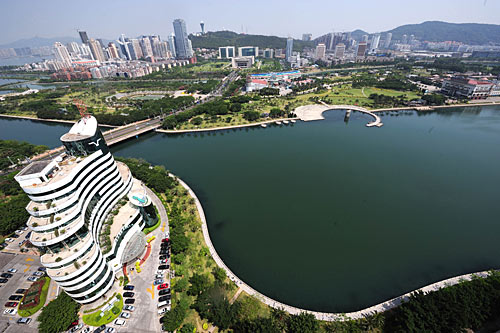|
Balancing Regional Economies
 |
|
(XINHUA) |
This year China continued to narrow the gap in regional development through regional economic revitalization.
On January 4, the State Council issued the Guidelines on Promoting Hainan as an International Tourist Destination, to boost tourism of the island. Hainan received a green light to tap into sports lotteries and open more duty-free shops for departing foreign tourists.
On January 12, the State Council approved Planning for the Wanjiang River Urban Belt as an Industrial Transfer Demonstration Zone. Wanjiang River Urban Belt refers to nine cities along parts of the Yangtze River flowing through Anhui Province. It is closely linked to the Yangtze River Delta geographically and culturally, and is critical to industrial relocation.
In April, the State Council approved a national development strategy for the Shenyang Metropolitan Area covering Shenyang and its eight neighboring cities. The core of this strategy is innovation in industrial development, integration of the eight cities, integration of urban and rural areas as well as interventions toward more market-oriented development.
A massive support package to help Xinjiang Uygur Autonomous Region achieve leapfrog-like development was unveiled at a central work conference on the region's development—the first of its kind in 60 years held in Beijing on May 17-19. A series of preferential policies including the resource tax reform (launched on June 1) were introduced.
The Regional Plan for the Yangtze River Delta was approved by the State Council on May 24. The Yangtze River Delta, embracing the Shanghai Municipality and Jiangsu and Zhejiang provinces, is the most developed region in the country. The plan says the Yangtze River Delta will be developed into a key international gateway for the Asia-Pacific region, an important global center for the modern service industry and advanced manufacturing industry.
Ten years after it unveiled a strategy to promote growth in its western area, China set goals for the western development endeavor over the next decade at a conference on July 5-6. The focus will be on enhancement of the economic strength of the western region to achieve a 10-percent economic growth rate by 2020.
The plan for southwest China's Chengdu-Chongqing economic zone was recently submitted to the State Council for approval. The zone is to include 15 cities in Sichuan Province and 31 districts or counties in Chongqing Municipality. The economic zone is aimed at becoming an economic engine for China's western region, and a base for advanced manufacturing, modern services, advanced technology and agricultural production.
| 